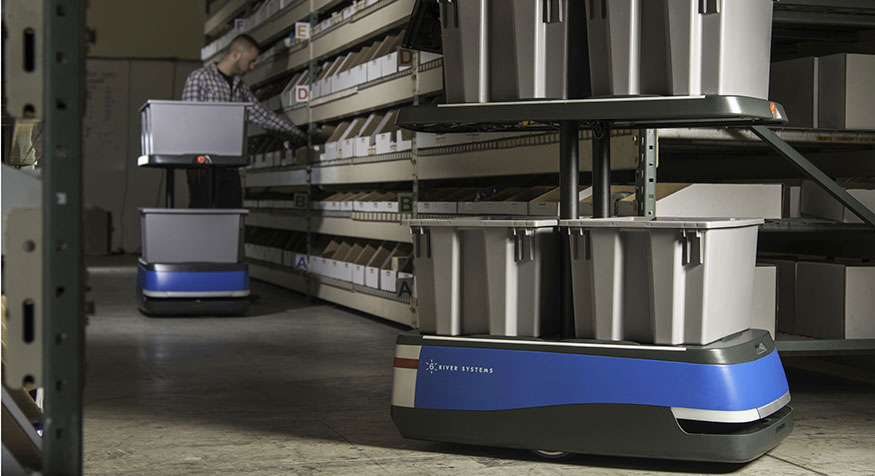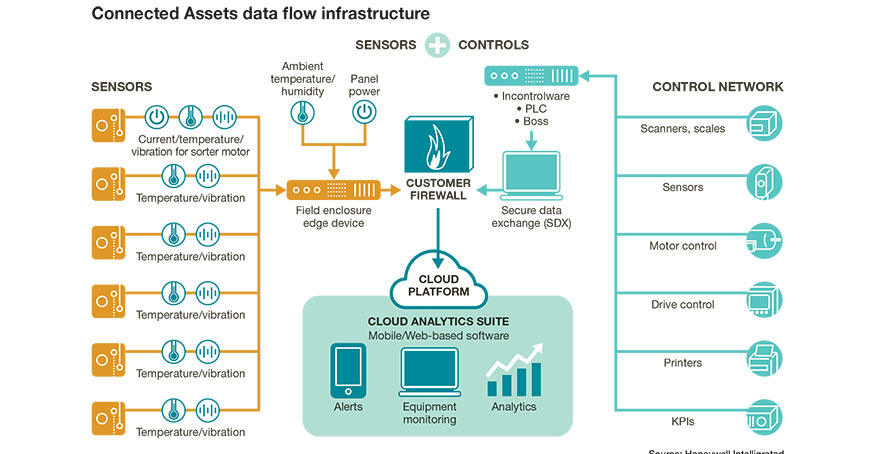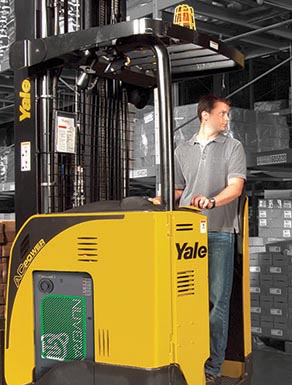The State of Internet of Things (IoT) in the Warehouse
Internet of Things is happening everywhere, from home thermostats to cars, to machinery in factories. Now IoT is taking hold in warehouses, though more slowly. But with more warehouse-focused vendors offering pretested sensors, prebuilt analytics and alerting around IoT-connected equipment, IoT should become more widespread in DCs.

Leveraging the Internet of Things (IoT) in warehouses may finally be turning from a conceptual thing to an actual thing, propelled by focused solutions aimed at distribution centers.
Today, more vendors are offering IoT-connected sensors for use in DCs, often with associated Cloud-based analytics software. These include temperature sensors for cold storage, vibration sensors for motors, and sensor data being relayed to the Cloud by solutions such as lift truck telematics or autonomous mobile robots (AMRs).
The challenge with gauging the state of IoT in the warehouse is that many systems generate data using sensors and can share information in the Cloud, but it’s a stretch to call every such system IoT. Many are traditional automation systems that relay data using controllers and industrial networks that include a layer of Web-based reporting. Under a pure IoT architecture, sensors or smart equipment send data to an IoT software platform in the Cloud, where the data can be filtered, organized, analyzed and leveraged by various applications. Some IoT devices also may process data locally at the “edge.”
Steve Banker, vice president of supply chain management research for analyst firm ARC Advisory Group, explains that if you define IoT strictly, there probably hasn’t been a great deal of IoT inside DCs, but more loosely defined to include leveraging sensor data using Cloud analytics, more has been going on. Many systems leverage sensor data and have some Web-based analytics, explains Banker.
“I’ve sort of stopped talking about IoT as much, and I’m talking more about what new forms of sensor data we can grab and use,” says Banker. “To me, the value is around getting new sensor data and using it. Getting too hung up on the architecture takes away from value.”
The drivers for IoT in DCs include monitoring asset health and uptime, both for materials handling systems crucial to order fulfillment and for “cold chain” monitoring of goods like foods or medicines. “One potential application is cold storage,” says Banker. “You want to be able to prove goods stayed within a needed temperature range.”

Autonomous mobile robots that wirelessly communicate information with a Cloud-based management system are one example of how IoT is taking shape in DCs.
As DCs have become more automated, ensuring high equipment uptime shapes up as a prime IoT focus. Eventually, data from sensors will be able to drive predictive analytics, notes David Trice, senior director of global parts operations, lifecycle performance services, for Materials Handling Systems (MHS), a warehouse automation integrator. “Wide ranging automation monitoring can help managers understand the health of their most critical assets and thus plan their maintenance schedules with a higher degree of efficiency,” Trice says. “As the data pool builds and asset models become clear, organizations are enabled to achieve true predictive maintenance.”
More warehouse-focused vendors are now offering simplified IoT solutions. Connected sensors and Cloud analytics are becoming standard options, rather than something users or consultants must build from scratch. This should open the door to more rapid uptake, making it easier for an operation to have a connected dock area, connected cold storage or a connected fleet of lift trucks.
Connected vehicles
In the warehouse world, connected vehicles means mobile robots and telematics-equipped lift trucks. While mobile robotics or “AMRs” differ somewhat in terms of their mode of working with people, most of these units can wirelessly communicate data to a robotic control system, many of which run in the Cloud.
According to Fergal Glynn, vice president of marketing with 6 River Systems, its robots, which are called “Chucks,” are IoT connected in that they are wirelessly transmitting data back to 6 River Systems’ Cloud-based software. There also is some local edge processing for sensors that will stop a Chuck instantly if someone walks in front of it or slow it down when it’s coming to a busy area. Each Chuck has a LIDAR navigation sensor and downloads a digital map of the DC.

The Connected Assets solution securely brings together data from IoT connected sensors and the controls layer and provides Cloud-based analytics and mobile information access. Image Source: Honeywell Intelligrated
The data from the robots lets the Cloud-based management system make efficient assignments for the Chucks and the human pickers who work alongside them. Rather than a goods-to-person AMR method in which robots slide under rolling shelves and bring goods to a human at a pick station, Chucks work in a different collaborative manner.
Each Chuck has a touchscreen, lights to guide workers, and a built-in bar code scanner, and it is set up to hold picked goods. The human workers stick to smaller zones, thus cutting their travel time, while a Chuck will come to them and guide them through a group of picks with minimal travel.
The connected communication between the Chucks and the Cloud software is used in multiple ways, says Glynn. The Cloud system uses its knowledge of the location of each robot, and how far along it is with current picks, to intelligently assign incoming work across the fleet of robots and ensure that when a picker is done filling one Chuck, an empty one is ready with more work.
In some cases, adds Glynn, if the Cloud software takes in a rush order from a higher-level system, it can reprioritize work so a Chuck and its human coworker quickly pick the items for the hot order so the Chuck can bring it straight to pack out. “In a steady state, the software will get the most amount of products onto a Chuck as possible, but there are going to be some scenarios where a tight delivery commitment will trump carrying density,” says Glynn.
The connectivity between Cloud software and mobile robots allows for analytics on resource utilization and productivity trends. The Cloud software can also spot patterns on how inventory location is impacting picking and may in some cases recommend item slotting changes so future picks will be more productive, says Glynn.
Lift truck telematics with prebuilt reporting and alerting software are another way IoT is taking hold in DCs. Telematics not only gives users near real-time visibility into utilization and truck availability, they are equipped with sensors to detect and track impact incidents while supporting software allows operators to perform safety checklists digitally. Perhaps most important, lift truck manufacturers have created software for fleet analytics based on the gathered data.
 For example, Yale Materials Handling Corp. now offers a mobile app for Android and iOS devices as a companion to the Yale Vision portal-style desktop telemetry application. “Our customers were wanting a closer interaction with their fleet assets and some of the trends and behaviors of their trucks and operators,” says Kevin Paramore, sales and marketing manager for Motive Power and Telematics at Yale Materials Handling. “They wanted a true mobile companion app.”
For example, Yale Materials Handling Corp. now offers a mobile app for Android and iOS devices as a companion to the Yale Vision portal-style desktop telemetry application. “Our customers were wanting a closer interaction with their fleet assets and some of the trends and behaviors of their trucks and operators,” says Kevin Paramore, sales and marketing manager for Motive Power and Telematics at Yale Materials Handling. “They wanted a true mobile companion app.”
The Yale app runs in the Cloud and provides analytics on trends like fleet utilization and safety incidents. The mobile aspect allows supervisors to add online notations or upload pictures of an impact or checklist event, which Paramore says “enriches” the base data. “The app can act as a digital note taker, which translates into more information within the higher-level reporting so you have better visibility into the root cause of incidents,” he says.
As the telematics gather more data on fleet trends, users can also use the app to make decisions on how to right-size a fleet, or perhaps require additional training for operators. The solution also has a load-sensing feature that can detect if lift trucks are running empty or with a load. If a lift truck is frequently running empty a high percentage of the time, it may be getting used primarily as a commuter vehicle and other vehicles might be better suited to that role.
Most user organizations will quickly leverage telematics to digitize tasks like safety checklists, adds Paramore, but typically, they want to see data accumulate for at least a few months before significantly downsizing or shuffling fleet makeup. But with telematics connectivity and analytics, managers have the information they need to make decisions. “Some organizations may wait to see trends accumulate over a longer period of time, and then with those insights, they are then ready to start sculpting the fleet or adjusting their processes,” Paramore says.
When equipment vendors begin offering sensor options and Cloud-based analytics, it tends to simplify IoT. An example of this is a connected dock visibility solution from Systems, provider of dock equipment such as levelers and truck restraints. Its iDock Connect solution combines data from sensors with subscription-based Cloud software for alerting and analytics to manage real-time dock activity.
One type of sensor, for example, is positioned by the leveler to monitor each time a forklift passes in and out of a trailer. Another type of sensor positioned over the dock door area is triggered every time a truck backs into position or leaves. The restraints also have sensors. Through a gateway that links to the dock equipment controller, the sensor data is transmitted to the Cloud, where Systems’ iDock software, a subscription-based solution, generates analysis, alerts and reports that users can access on a smart phone, tablet or PC apps.
Managers can be anywhere and be notified of events like truck arrivals, restraints being bypassed, or inefficient load/unload events. For example, forklift activity sensors can show that a truck was at a dock for a full hour, but only 20 minutes involved load/unloading activity, explains Brett Lindstrom, Systems’ marketing and communications director.
This type of IoT-based visibility into dock activity can help correct issues before they become big problems, says Lindstrom. “First and foremost are the efficiency improvement of dock activity monitoring,” he says. “You also can achieve improvements in maintenance and safety processes, but the key for many users will be that the alerting and analytics help find operational efficiencies.”
Automation meets IoT
Automated materials handling systems like conveyors and sorters have always been connected, just not under IoT. Systems like conveyor and sortation have been around for decades, using technology like programmable logic controllers, industrial networks, fixed position bar code readers, and photo eyes to control movement and govern proper material flow. Many automation systems feed data into a warehouse control system (WCS) or warehouse execution system (WES) that has a data repository and reporting views.
Historically, however, these warehouse automation systems have resided inside the four walls on wired networks. This is changing with more automation vendors now offering Web-based or Cloud-based analytics to help manage performance. Now some warehouse automation vendors are adding new types of sensor options to their solutions, as well as Cloud analytics platforms that can apply machine learning for purposes such as predictive maintenance.
For instance, in March, Honeywell Intelligrated launched a “Connected Assets” solution that will leverage additional sensor data and feed it into an advanced analytics software platform, says Eric Rice, Honeywell Intelligrated’s principal product marketing manager for Connected DC. The analytics platform is a called Uniformance, and comes from parent company Honeywell. This platform has been widely used in the oil and gas sector.
But Honeywell Intelligrated isn’t just offering up sensors and a raw software platform, notes Rice. The company has configured Uniformance to analyze asset health for key materials handling systems components such as motors, leveraging data from pretested sensor options like vibration sensors. The intent is to make IoT analysis of the health of critical warehouse assets more of a packaged solution, Rice explains. “I think there needs to be a base solution that provides value to the customer pretty quickly,” he says.
Another twist with the solution, says Rice, is that it will compare and correlate insights from the sensor data with control system data from the automation that provides visibility into how well the machinery is running. “Putting those two types of information together can add a lot of value from the end user in terms of asset health and also in being able to visualize performance on, say, a sortation system, so you are better able to drive up efficiency,” says Rice.
The Connected Assets solution started with testing in Honeywell Intelligrated’s demo center, says Rice, and as of early 2019, multiple pilots were underway at customer sites.
At Dematic, which provides many types of warehouse automation, the company is working on incorporating IoT readiness to capture critical data from subsystems, according to Scott Wahl, Dematic vice president for global software solutions. The company is also working to connect data from equipment and software systems into a common platform. Some Dematic solutions like its automatic guided vehicles (AGVs), Wahl adds, already generate large amounts of data that can be accessed for historical trending and advanced predictive modeling.
The biggest challenge in achieving success with connected solutions, adds Wahl, will likely be on the analytics side, where having a provider with materials handling domain expertise makes a big difference in how well the analytics work. “For many organizations, the issue is not the collection of new asset data—it is the actual analysis of what they already have,” Wahl says. “For example, a DC can receive up to 5 terabytes of data a day from a single conveyor line, but may not know if the data they already have—and what they continue to receive—is from an asset that is still throughput critical for a work order or how it may relate to the rest of the DC operation.”
The upshot is that IoT solutions for the warehouse will likely need a combination of appropriate sensors, a software platform with advanced analytics, and a provider with domain expertise. As Wahl puts it, “IoT technology is just the enabler to obtain additional data from equipment that might not already be providing it. The real effort, and value, is in combining data from disparate systems and equipment into a single source of truth.”
Simplicity sought
While vendors of materials handling equipment are in some cases coming up with pre-tested sensor options for their equipment, end-user organizations can turn to sensor providers to add monitoring to many types of industrial equipment, from vibration sensors on motors to temperature sensors in cold storage DCs. Some pallets can even house sensors.
Sensor options also are expanding. For example, a recent partnership between Smartrac Technology Group, a provider of radio frequency identification (RFID) products and IoT solutions, and Axzon, a wireless sensing solution provider, is focused on battery-less sensors that could expand the range of assets that are candidates for IoT applications. Through the partnership, Smartrac will be able to offer battery-less RFID based sensors and tags that can be read with existing RFID infrastructure, according to Hal Hikita, senior vice president for product management with Smartrac. Once “read,” the data is transmitted to the Cloud.
The battery-less sensors can be deployed where active or semi-active sensors are not economically or practically feasible, says Hikita. “Up to now, most use cases for digitization in warehouses and supply chains is related to the machinery and infrastructure that make a warehouse work. These components usually have energy supply and enough value to justify a relatively expensive connection to the IoT. With RFID in general and RFID-based sensing technology, a plethora of mid- and high-value assets stored in the warehouse can be connected in an economical manner. That enables a broader range of applications related to condition monitoring, including, but not limited to, cold chain [monitoring].”
Existing systems in warehouses can be fitted with sensors that feed data into Cloud-based alerting and analytics, says Nick Mecham, vice president of business development for Monnit Corp., a vendor of sensors that support IoT. Mecham says Monnit offers about 60 different sensors to monitor variables such as vibration, temperature, motion and humidity, as well as software and mobile apps that handle alerting and reporting.
In warehouses, says Mecham, the IoT applications Monnit has been involved with include monitoring temperature variations in cold storage areas and monitoring heat and vibration being generated by motors on materials handling systems. Its clients for warehouse cold storage monitoring include Lineage Logistics.
With IoT-connected temperature sensors in a cold storage, says Mecham, user organizations typically want alerts when temperatures swing out of threshold, but they also can benefit from analyzing more subtle temperature issues. At one user company, says Mecham, the sensor data was used to make a “heat map” that showed hot spot areas within cold storage. This analysis, says Mecham, helped pinpoint adjustments to the ventilation or the way storage is configured to promote even, steady cooling.
Most vendors involved with IoT for the warehouse agree that to enable greater IoT uptake, vendors need to make it relatively easy to set up sensors, alerting and associated analytics. There may never be an “out the box” IoT solution for every purpose in a DC operation, but as Mecham observes, “We realize that customers don’t want to be technologists focused on putting together IoT solutions,” he says. “They want to be able to select a product, easily deploy it and start gathering the data they are looking for.”
Companies mentioned in this article:
- 6 River Systems
- ARC Advisory Group
- Dematic
- Honeywell Intelligrated
- Materials Handling Systems (MHS)
- Monnit Corporation
- Smartrac Technology Group
- Systems
- Yale Materials Handling Corp.

Article Topics
IoT News & Resources
The reBound Podcast: Innovation in the 3PL supply chain The reBound: Who’s afraid of AI? Not us. The Rebound: 3D Transformation at GE Appliances Transformation and resilience at the new J&J Powerfleet and MiX Telematics announce business combination Maersk tackles flexibility and variability with innovation Bosch Rexroth announces departure of president and CEO, Gregory Gumbs More IoTLatest in Materials Handling
Registration open for Pack Expo International 2024 Walmart chooses Swisslog AS/RS and software for third milk processing facility NetLogistik partners with Vuzix subsidiary Moviynt to offer mobility solutions for warehouses Materials Handling Robotics: The new world of heterogeneous robotic integration BSLBATT is looking for new distributors and resellers worldwide Lucas Watson appointed CSO for Körber’s Parcel Logistics business in North America Hyster recognizes Dealers of Distinction for 2023 More Materials HandlingAbout the Author
Subscribe to Materials Handling Magazine

Find out what the world's most innovative companies are doing to improve productivity in their plants and distribution centers.
Start your FREE subscription today.
April 2024 Modern Materials Handling

Latest Resources










